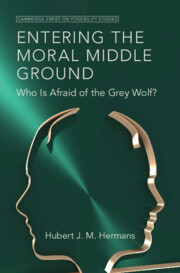54 results
Figures
-
- Book:
- Entering the Moral Middle Ground
- Published online:
- 15 March 2024
- Print publication:
- 28 March 2024, pp x-xi
-
- Chapter
- Export citation
Acknowledgments
-
- Book:
- Entering the Moral Middle Ground
- Published online:
- 15 March 2024
- Print publication:
- 28 March 2024, pp xvi-xvi
-
- Chapter
- Export citation
Index
-
- Book:
- Entering the Moral Middle Ground
- Published online:
- 15 March 2024
- Print publication:
- 28 March 2024, pp 296-310
-
- Chapter
- Export citation
Dedication
-
- Book:
- Entering the Moral Middle Ground
- Published online:
- 15 March 2024
- Print publication:
- 28 March 2024, pp v-vi
-
- Chapter
- Export citation
Chapter 5 - Contradiction as Intrinsic to the Multiplicity of the Self
-
- Book:
- Entering the Moral Middle Ground
- Published online:
- 15 March 2024
- Print publication:
- 28 March 2024, pp 185-222
-
- Chapter
- Export citation
Glossary
-
- Book:
- Entering the Moral Middle Ground
- Published online:
- 15 March 2024
- Print publication:
- 28 March 2024, pp 279-281
-
- Chapter
- Export citation
Chapter 1 - Dialogical Self Theory and the Process of Positioning
-
- Book:
- Entering the Moral Middle Ground
- Published online:
- 15 March 2024
- Print publication:
- 28 March 2024, pp 23-49
-
- Chapter
- Export citation
Chapter 3 - Rejecting Bad via Externalization
-
- Book:
- Entering the Moral Middle Ground
- Published online:
- 15 March 2024
- Print publication:
- 28 March 2024, pp 86-143
-
- Chapter
- Export citation
Chapter 2 - Embracing Bad as Good via Internalization
-
- Book:
- Entering the Moral Middle Ground
- Published online:
- 15 March 2024
- Print publication:
- 28 March 2024, pp 50-85
-
- Chapter
- Export citation
Copyright page
-
- Book:
- Entering the Moral Middle Ground
- Published online:
- 15 March 2024
- Print publication:
- 28 March 2024, pp iv-iv
-
- Chapter
- Export citation
Introduction
-
- Book:
- Entering the Moral Middle Ground
- Published online:
- 15 March 2024
- Print publication:
- 28 March 2024, pp 1-22
-
- Chapter
- Export citation
Contents
-
- Book:
- Entering the Moral Middle Ground
- Published online:
- 15 March 2024
- Print publication:
- 28 March 2024, pp vii-ix
-
- Chapter
- Export citation
Chapter 4 - The Vitality of the Moral Middle Ground
-
- Book:
- Entering the Moral Middle Ground
- Published online:
- 15 March 2024
- Print publication:
- 28 March 2024, pp 144-184
-
- Chapter
- Export citation
Chapter 6 - Multilevel Identity and the Moral Middle Ground
-
- Book:
- Entering the Moral Middle Ground
- Published online:
- 15 March 2024
- Print publication:
- 28 March 2024, pp 223-278
-
- Chapter
- Export citation
Preface
-
- Book:
- Entering the Moral Middle Ground
- Published online:
- 15 March 2024
- Print publication:
- 28 March 2024, pp xiii-xv
-
- Chapter
- Export citation
References
-
- Book:
- Entering the Moral Middle Ground
- Published online:
- 15 March 2024
- Print publication:
- 28 March 2024, pp 282-295
-
- Chapter
- Export citation
Tables
-
- Book:
- Entering the Moral Middle Ground
- Published online:
- 15 March 2024
- Print publication:
- 28 March 2024, pp xii-xii
-
- Chapter
- Export citation

Entering the Moral Middle Ground
- Who Is Afraid of the Grey Wolf?
-
- Published online:
- 15 March 2024
- Print publication:
- 28 March 2024
Preface
-
- Book:
- Liberation in the Face of Uncertainty
- Published online:
- 06 January 2022
- Print publication:
- 13 January 2022, pp xiii-xv
-
- Chapter
- Export citation
References
-
- Book:
- Liberation in the Face of Uncertainty
- Published online:
- 06 January 2022
- Print publication:
- 13 January 2022, pp 295-312
-
- Chapter
- Export citation

